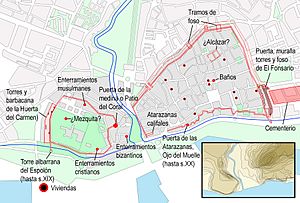Siege of Algeciras (1309–1310) facts for kids
Quick facts for kids Siege of Algeciras |
|||||||
|---|---|---|---|---|---|---|---|
| Part of the Reconquista | |||||||
 A Medieval archaeological rendering of Algeciras. |
|||||||
|
|||||||
| Belligerents | |||||||
| Commanders and leaders | |||||||
The Siege of Algeciras was a big battle in Spain's history. It happened between July 1309 and January 1310. This battle was part of the Reconquista, a long period when Christian kingdoms tried to take back land from Muslim rule.
The fight was between the Kingdom of Castile, led by King Ferdinand IV of Castile, and the Emirate of Granada, led by Sultan Abu'l-Juyush Nasr. Castile's army tried to capture the city of Algeciras. However, they had to give up because of terrible conditions in their camp. Many soldiers also left, including a powerful prince named Infante John of Castile. This battle was one of many times Christian forces tried and failed to take Algeciras from the Muslims.
Contents
Why the Siege Happened
In December 1308, King Ferdinand IV of Castile made a deal with the Kingdom of Aragon. This deal was called the Treaty of Alcalá de Henares. They agreed to start a war against the Kingdom of Granada in June 1309.
- Castile would attack the cities of Algeciras and Gibraltar.
- Aragon would attack the city of Almería.
- They also agreed to work together with their navies. This would help block Granadan towns by sea.
King Ferdinand IV promised to give Aragon a part of the land they conquered. Some of his nobles, like Infante John of Castile and Don Juan Manuel, were not happy about this. They thought Aragon was getting too much.
To get more support, Castile and Aragon asked Pope Clement V for help. The Pope agreed to make the war a Crusade. This meant it was a holy war, and many people would support it. The Pope also allowed King Ferdinand to collect special taxes from churches for three years to pay for the war.
Many powerful nobles in Castile did not want to attack Algeciras. They thought it was too strong. Algeciras had been a major Muslim city for a long time and was very well protected. Despite these worries, the Castilian army gathered in Toledo. King Ferdinand IV left his mother, María de Molina, in charge of the government while he was away.
Getting Ready for Battle
Many important leaders brought their soldiers to fight for Castile. These included Infante John of Castile, Don Juan Manuel, and Diego Lopez V de Haro. Many regular soldiers also came from cities like Salamanca and Seville.
Even Denis of Portugal, a relative of King Ferdinand, sent 700 knights to help. James II of Aragon also sent 10 ships to help block Algeciras by sea.
King Ferdinand and his army marched from Toledo to Córdoba. Then they went to Seville, where they made their final plans. Supplies for the army were sent by sea to Algeciras.
The Siege Begins
On July 27, 1309, the first Castilian soldiers arrived at Algeciras. King Ferdinand and the rest of the army arrived three days later. At the same time, King James II of Aragon began his attack on Almería.
While the siege of Algeciras was happening, Castilian forces had a big success. On September 12, 1309, soldiers led by Juan Núñez II de Lara and Alonso Pérez de Guzmán captured the city of Gibraltar. This victory made the Castilian army feel much better.
However, things soon got difficult for the Castilian army. In mid-October 1309, several important leaders left the camp. These included Infante John of Castile, his son, and Don Juan Manuel. They took about 500 knights with them. They said the living conditions were bad and they hadn't been paid. This act was seen as a betrayal across Europe. Even the King of Aragon tried to convince them to return, but they refused.
Despite this, King Ferdinand IV kept fighting. He still had the support of Juan Núñez II de Lara and Diego Lopez V de Haro.
Life in the Castilian camp became very hard. The king even had to sell his wife's jewelry to pay the soldiers. More soldiers arrived to help, sent by Prince Felipe de Castilla y Molina and the Archbishop of Santiago de Compostela.
Towards the end of 1309, the siege got even worse. Many commanders became sick. Diego Lopez V de Haro got very ill, and Alonso Pérez de Guzmán died. Heavy rains flooded the camp, making diseases spread quickly. King Ferdinand IV kept trying until January 1310, but he finally gave up hope of winning.
What Happened Next
In January 1310, King Ferdinand IV started talking with the Kingdom of Granada. They made a peace deal. King Ferdinand agreed to stop the siege. In return, he received some border towns and a payment of 5,000 gold coins.
Right after this peace treaty was signed, Diego Lopez V de Haro died in the camp at Algeciras. Around the same time, King James II of Aragon also ended his unsuccessful siege of Almería.
Even though King Ferdinand IV did not capture Algeciras, the campaign was still a success for him. This is because the city of Gibraltar became part of Castile.
See also
 In Spanish: Sitio de Algeciras (1309-1310) para niños
In Spanish: Sitio de Algeciras (1309-1310) para niños

